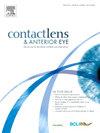The repeatability of tests for dry eye signs and symptoms in the dry eye assessment and management (DREAM) study
IF 4.1
3区 医学
Q1 OPHTHALMOLOGY
引用次数: 0
Abstract
Purpose
To assess the repeatability of measures for dry eye disease (DED) symptoms and signs in the DREAM study.
Methods
At screening and baseline visits approximately 2 weeks apart, participants were assessed for symptoms by Ocular Surface Disease Index (OSDI) and Brief Ocular Discomfort Index (BODI), and signs by the same physician in the same order: tear break-up time (TBUT), corneal staining, conjunctival staining, Meibomian gland evaluation, and the Schirmer test. The repeatability of DED symptoms and signs was assessed by interclass correlation coefficient (ICC), 95 % limits of agreement, and the percent of eyes with inter-visit difference above the clinically significant threshold.
Results
Among 1046 eyes (523 participants), ICC for signs ranged from 0.53 (TBUT) to 0.73 (corneal staining). A substantial percentage of eyes showed clinically significant inter-visit differences: ≥2 points in 17.8 % of eyes for conjunctival staining; ≥3 points in 18.8 % for corneal staining; >2 s in 14.1 % for TBUT; ≥5 mm/5 min in 29.9 % for the Schirmer test, and ≥ 2 points in 27.5 % for Meibomian gland plugging and lid secretion. The OSDI and BODI had ICC of 0.64 and 0.63 respectively, and nearly 40 % of participants had inter-visit score differences ≥ 10 points.
Conclusion
In DREAM participants with moderate-to-severe DED, DED signs and symptoms had moderate repeatability, with ocular surface staining scores being the most repeatable and TBUT the least repeatable. A notable percentage of participants had inter-visit differences above the clinically meaningful threshold. These test–retest variabilities in DED signs and symptoms should be considered for designing clinical trials and monitoring disease progression.
干眼症评估和管理 (DREAM) 研究中干眼症体征和症状测试的可重复性。
目的:评估 DREAM 研究中干眼症 (DED) 症状和体征测量的可重复性:在相隔约两周的筛查和基线检查中,由同一医生按照相同的顺序对参与者进行眼表疾病指数(OSDI)和简易眼部不适指数(BODI)的症状评估,以及泪液破裂时间(TBUT)、角膜染色、结膜染色、睑板腺评估和施尔默试验的体征评估。DED症状和体征的重复性通过类间相关系数(ICC)、95%的一致性限值以及访问间差异超过临床显著阈值的眼睛百分比进行评估:在 1046 只眼睛(523 名参与者)中,体征的 ICC 从 0.53(TBUT)到 0.73(角膜染色)不等。相当一部分眼睛的检查间差异具有临床意义:17.8%的眼睛结膜染色≥2点;18.8%的眼睛角膜染色≥3点;14.1%的眼睛TBUT>2秒;29.9%的眼睛Schirmer试验≥5毫米/5分钟;27.5%的眼睛睑板腺堵塞和眼睑分泌物≥2点。OSDI和BODI的ICC分别为0.64和0.63,近40%的参与者在两次检查之间的得分差异≥10分:在患有中度至重度 DED 的 DREAM 参与者中,DED 体征和症状具有适度的可重复性,其中眼表染色评分的可重复性最高,TBUT 的可重复性最低。有相当一部分参与者的两次检查之间的差异超过了有临床意义的临界值。在设计临床试验和监测疾病进展时,应考虑到 DED 体征和症状的这些测试重复变异性。
本文章由计算机程序翻译,如有差异,请以英文原文为准。
求助全文
约1分钟内获得全文
求助全文
来源期刊

Contact Lens & Anterior Eye
OPHTHALMOLOGY-
CiteScore
7.60
自引率
18.80%
发文量
198
审稿时长
55 days
期刊介绍:
Contact Lens & Anterior Eye is a research-based journal covering all aspects of contact lens theory and practice, including original articles on invention and innovations, as well as the regular features of: Case Reports; Literary Reviews; Editorials; Instrumentation and Techniques and Dates of Professional Meetings.
 求助内容:
求助内容: 应助结果提醒方式:
应助结果提醒方式:


